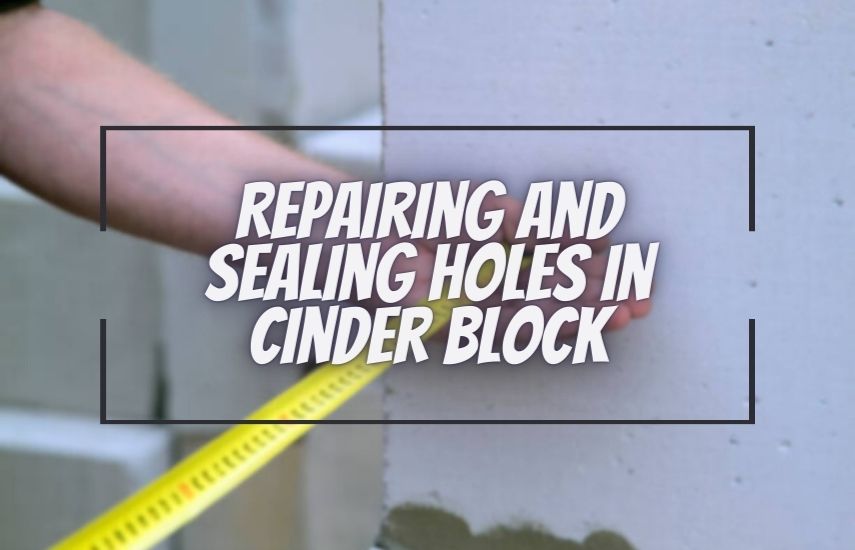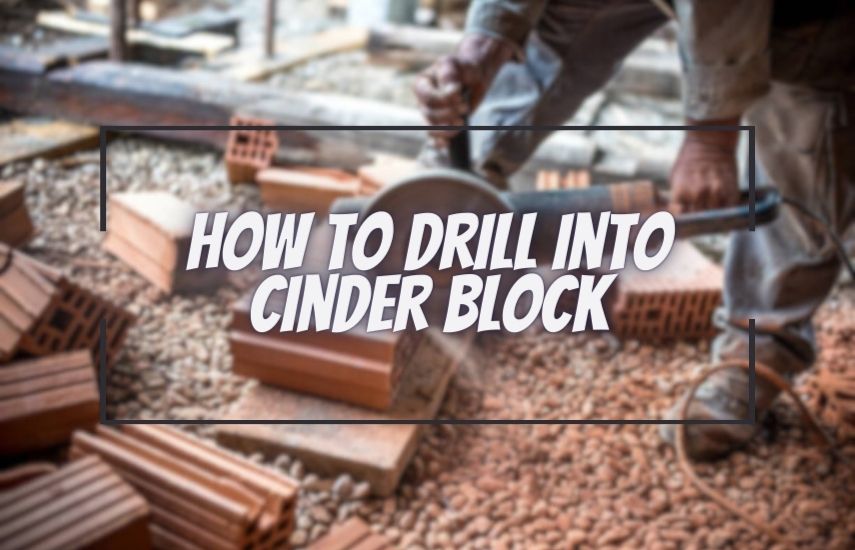When you need to hang something on a cinder block wall or make a hole for water or electricity, you have to drill into the blocks.
Many people, both professionals and beginners, have had trouble drilling into cinder blocks, especially if they don’t have the right tools or know-how.
How to Drill Into Cinder Block? You’ll need a hammer drill and a masonry bit to drill into the cone block.
Put on safety gear, mark the spot where you want to drill, and start digging slowly.
To keep the area cool and free of dust, use water. If you need to, clean the hole and put in bolts or screws.
This blog is for people like these. You can do the job right by following these steps on how to drill into cinder blocks in a safe and effective way.
Safety and Preparation
Before drilling into concrete blocks, you need to be safe and take the right steps. This means putting on safety gear and getting the drilling spot ready.
We will talk about safety gear, choosing the right drill and bit, and marking and measuring the drilling area to make sure the job goes well and everyone stays safe.
Necessary safety equipment
To avoid dangers, employ safety gear when drilling cinder block. Consider this safety equipment:
- Wear safety goggles to avoid dust and debris flying off the block when drilling.
- Drilling with a dust mask prevents inhaling dust and debris.
- Plugs or earmuffs: Drilling is loud, so wear them to protect your hearing.
- Work gloves: Cinder block edges are sharp, so use gloves to protect your hands and fingers.
Choosing the right drill and bits
When drilling into cinder block, it is important to choose the right drill and bits to ensure successful drilling. Here are some factors to consider when selecting the right drill and bits:
- Hammer drill: A hammer drill is the most effective tool for drilling into cinder blocks. It uses a piston-like mechanism to create a hammering motion, which makes it easier to penetrate the tough material.
- Masonry bit: A masonry bit is designed specifically for drilling into concrete, brick, and cinder blocks. It has a carbide tip that can withstand the hardness of these materials.
- Bit size: The size of the bit will depend on the size of the hole needed. Be sure to select the right size bit for the job.
Marking and measuring the drilling area
To be accurate and keep the nearby area from getting damaged, the drilling area must be marked and measured. To do this, take these steps:
- Use a pencil to mark the spot where you want to drill.
- Use a tape measure or ruler to measure the distance between the marks.
- Double-check the measurements and ensure they are accurate.
- Use painter’s tape to create a border around the drilling area. This will help prevent the drill bit from slipping and causing damage to the surrounding area.
By taking the necessary safety precautions and preparing the area properly, you can ensure a safe and successful drilling experience when drilling into cinder block.
6 Steps to Drilling into Cinder Block

Even though it can be hard to drill into cinder blocks, it can be done well with the right tools and steps.
For mounting shelves, hanging art, and putting in electrical outlets, you need to plan ahead and drill into cinder blocks.
We’ll show you how to drill cement blocks and give you tips on how to do it right.
Step 1: Preparing the drilling area
Before you drill into the concrete block, you have to get the drilling area ready. Get rid of any dirt or dust on the surface.
Use a measuring tape and pencil to mark where you want to drill. Level and centre the mark.
Use a stud finder to make sure that the cinder block doesn’t have any plumbing or electrical lines running through it.
Step 2: Securing the cinder block
Putting the cement block in place keeps it from moving or breaking while the drill is going on. Attach a piece of scrap wood to a workbench or table and place it under the cinder block.
A brick anchor can also be used to connect the cinder block to the wall.
Step 3: Choosing the right drilling technique
You can drill into cement blocks with a hammer, a rotary drill, or a percussion drill. The most common way is hammer drilling, which works well for small to medium-sized holes.
For bigger holes, rotary drilling is best, while percussion drilling is better for cinder blocks that are heavier. Pick the drilling method you like best.
Step 4: Drilling pilot holes
Before drilling the last hole, pilot holes need to be made. With pilot holes, the drill bit can move more smoothly, and the cinder block won’t crack or chip.
To make a pilot hole, start with a small drill bit. Then, slowly raise the size of the drill bit until you get the hole you want.
Step 5: Drilling the final hole
The last hole should be drilled after the test hole. When you drill, use steady, regular pressure and stay away from force.
Carefully drill with the drill bit straight down from the cement block to keep it from getting too hot and make a clean hole.
Step 6: Cleaning and finishing the drilled hole
After the hole is drilled, the cinder block needs to be cleaned of dust and dirt. Use a wire brush or hoover to get rid of fine dust and dirt.
Use masonry sealer to close off the hole and keep water out. Put the pin or screw into the hole to hang your thing.
Last but not least, digging into cinder block requires planning, tools, and action. If you follow these steps, drilling into cinder block will be easy and successful.
Wear safety glasses, gloves, and a dust mask to prevent injury from dust and debris.
Tips for Drilling into Cinder Block
With the right tools, drilling into cinder blocks can be done quickly and easily. For shelves, pictures, and TVs, drilling into cinder blocks needs to be carefully planned and carried out.
We will help you drill into cinder block, including getting past problems, making holes that are straight and level, drilling into solid or hollow parts, and fixing damage and cracks.
Dealing with obstacles during drilling
Concrete anchors or rebar may be able to stop the drilling of cinder blocks. These things can hurt your drill bit and make it hard to drill. Here are some tips for drilling around obstacles:
- Use a hammer drill: A hammer drill is designed to break through tough materials, such as concrete and cinder block. It can also help to break up any obstacles that may be present.
- Use a masonry bit: A masonry bit is specifically designed for drilling into concrete and cinder block. It has a carbide tip that can withstand the tough material and is less likely to break.
- Use a metal detector: If you suspect there may be rebar or other metal obstacles in the cinder block, use a metal detector to locate them before drilling. This will help you avoid damaging your drill bit and ensure that you drill in the right spot.
Ensuring straight and level holes
Make sure your cinder block holes are straight and level before drilling. This will ensure a proper installation and minimise wobbling. Tips for straight, level holes:
- Use a level: Before drilling, use a level to mark a straight line where you want to drill. This will help you ensure that your holes are straight and level.
- Use a drill guide: A drill guide can help you keep your drill bit straight and level while drilling. It attaches to your drill and provides a guide for your drill bit.
- Start with a small hole: Starting with a small pilot hole can help you ensure that your larger hole is straight and level. Use a smaller drill bit to create a pilot hole before using a larger drill bit for the final hole.
Drilling into hollow or solid sections
Drilling hollow or solid cinder blocks involves different methods. Tips for drilling hollow or solid sections:
- Hollow cinder block: When drilling into a hollow cinder block, start by drilling a pilot hole to determine the depth of the cavity. Then, use a toggle bolt or other type of anchor that is designed for use in hollow walls.
- Solid cinder block: When drilling into a solid cinder block, use a masonry bit and drill at a slow speed. Apply steady pressure and avoid forcing the drill bit through the material.
Handling cracks and damage during drilling
Cinder bricks can crack when drilled. How to handle drilling cracks and damage:
- Stop drilling immediately: If you notice that your drill bit is causing cracks or damage, stop drilling immediately. Continuing to drill can make the problem worse and may even cause the cinder block to break.
- Use a different drill bit: If your drill bit is causing damage, try switching to a different type of drill bit, such as a diamond-tipped bit. This may be able to handle the tough material without causing damage.
- Fill in cracks: If you do end up causing cracks or damage, fill them in with epoxy or another type
Repairing and Sealing Holes in Cinder Block

Cinder blocks are often used for building foundations, retaining walls and other structures because they are strong and last a long time.
But cutting into them can leave holes or gaps that need to be filled and sealed to keep water out and stop more damage.
We will talk about how to fix small cracks or holes in cement blocks, how to fill in bigger holes, and how to keep water from damaging the blocks.
Repairing Small Holes or Cracks
If you have the right tools and materials, it’s easy to fix small holes or cracks in cinder blocks. Here are the steps you need to take:
- Clean the damaged area: Use a wire brush or scraper to remove any loose debris or dust from the hole or crack.
- Prepare the filler: Mix a small amount of hydraulic cement or quick-setting patching compound according to the manufacturer’s instructions. Make sure to wear protective gloves and goggles when handling the filler.
- Apply the filler: Use a putty knife or trowel to apply the filler to the hole or crack. Press the filler firmly into the damaged area and smooth the surface with the putty knife.
- Allow the filler to dry: Let the filler dry for at least 24 hours or as recommended by the manufacturer. Once the filler is dry, you can sand it lightly to smooth out any rough spots.
Sealing Larger Holes or Gaps
If you have a larger hole or gap in a cinder block, you will need to use a different approach to seal it properly. Here are the steps to follow:
- Clean the damaged area: Use a wire brush or scraper to remove any loose debris or dust from the hole or gap.
- Prepare the filler: Mix a hydraulic cement or epoxy filler according to the manufacturer’s instructions. Wear protective gloves and goggles when handling the filler.
- Apply the filler: Use a putty knife or trowel to apply the filler to the hole or gap. Press the filler firmly into the damaged area and smooth the surface with the putty knife.
- Allow the filler to dry: Let the filler dry for at least 24 hours or as recommended by the manufacturer. Once the filler is dry, you can sand it lightly to smooth out any rough spots.
- Seal the surface: Apply a coat of sealer over the repaired area to prevent moisture from penetrating the surface.
Preventing Moisture Issues and Damage
Preventing moisture issues and damage in cinder blocks is crucial to maintaining their structural integrity. Here are some tips to keep in mind:
- Use a waterproof sealer: Apply a waterproof sealer to the surface of the cinder blocks to prevent moisture from penetrating the surface.
- Keep the area dry. Avoid exposing the cinder blocks to excessive moisture or water. Make sure the area around the cinder blocks has proper drainage.
- Inspect the blocks regularly: Check the cinder blocks regularly for any signs of damage or moisture issues. Repair any damage as soon as possible to prevent further damage.
Repair and seal cinder block holes with these techniques to avoid moisture and future damage.
Common Mistakes to Avoid

It might look easy to drill into cinder block, but it’s important to avoid common mistakes that could damage or hurt the block.
We will talk about the most common mistakes people make when they drill into cement blocks and how to avoid them.
Using the Wrong Drill or Bits
A common mistake is to drill cement blocks with the wrong drill or bits. Because cinder brick is thick, you need a strong drill and special tools to work with it.
If you use a regular drill or the wrong bits, it could get too hot, break, and make the job harder.
To drill through cinder block, use a hammer drill with a masonry bit that has a steel tip. The carbide tip keeps the bit safe from the hard ash block.
Pick the right bit size for the job as well. It won’t work if the bit is too small, and it can break the drill if it’s too big.
Drilling Too Deep or Shallow
Not drilling deep enough or too little into brick blocks is another common mistake. It’s more likely for cement blocks to crack or break if you drill too deeply.
Deep cutting, on the other hand, makes it hard to attach anything to the block.
Take the time to measure and mark the depth of the hole before you start cutting. And this will help you drill to the right depth so you don’t damage the brick blocks.
Also, start with a small pilot hole and make it bigger and bigger until you hit the right depth.
Skipping Safety Precautions
To keep people from getting hurt, drill into cinder blocks safely. People often forget to follow safety rules, which leads to major accidents.
Protect your eyes, hands, and face with a dust mask at all times. Clear the area of any burning materials, and keep the drill away from them.
Overloading or Overheating the Drill
Another common mistake that can hurt or harm is heating the drill too much. If you drill too fast or with too much pressure, the drill could get too hot and break.
Iron blocks can also be cracked or broken. Using a moderate speed and constant pressure will help you avoid drill overload and burning.
Do not push on the drill; let it work on its own. Stop and let the drill cool down if it gets too hot before continuing.
Do not make these common mistakes when drilling brick blocks.
Pick the right drill and bits, mark and measure the depth of the hole, be careful, and keep the speed and pressure steady so the drill doesn’t get too hot or overloaded.
Conclusion
Very good work! Now you know how to drill into brick blocks. Finally, we talked about getting ready for the drill by cleaning up and collecting supplies and equipment.
We also talked about how to pick out and use a drill bit so that you and the cinder block don’t get hurt.We talked about ways to speed up the digging process.
After practising, you might find yourself in situations that call for a different reaction. A variety of ways to learn is generally a good thing.
Anyone can help in groups for home improvement and do-it-yourself projects.
Always do what the tool or object says to do. In this way, the right method and instruments are used. You can learn how to drill cinder blocks from how-to lessons on YouTube.
You can use these tips and tools to help you with your next cinder block drilling job. Safety should always come first, and you should take your time to do the job right.









